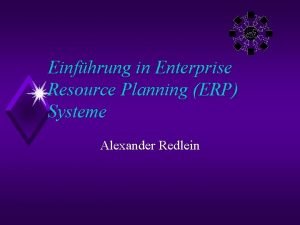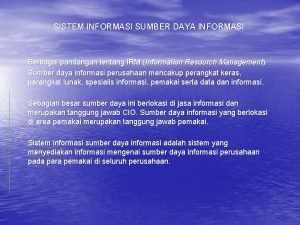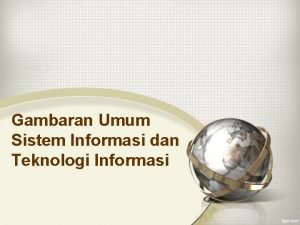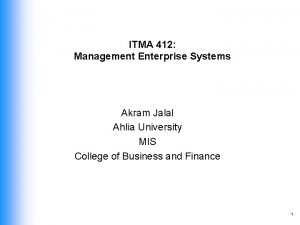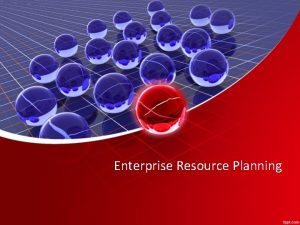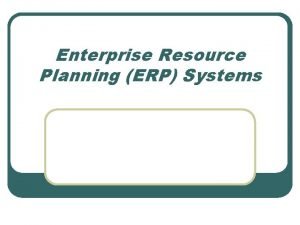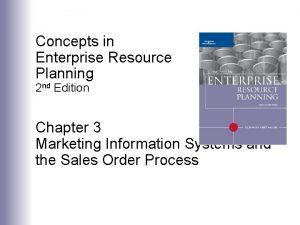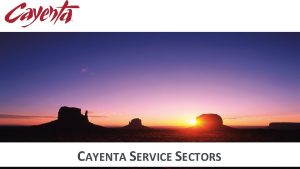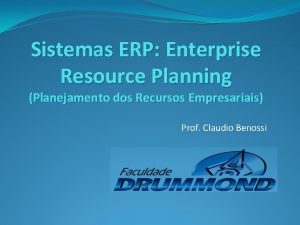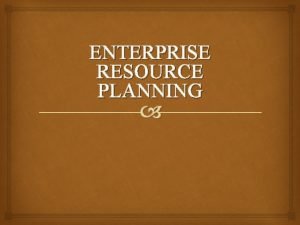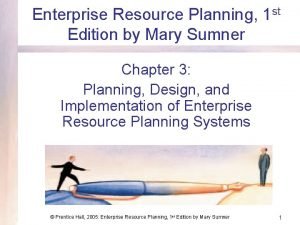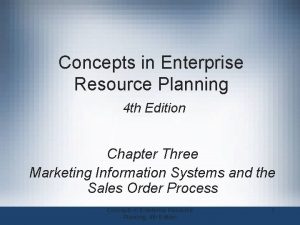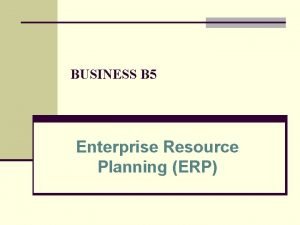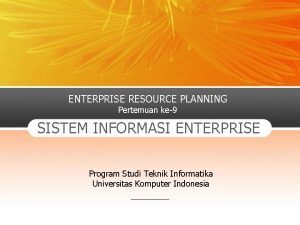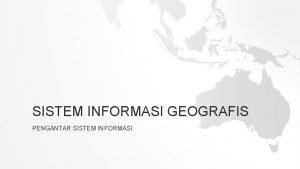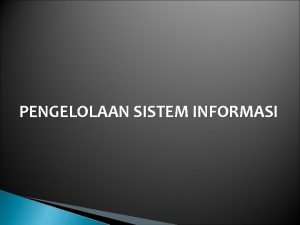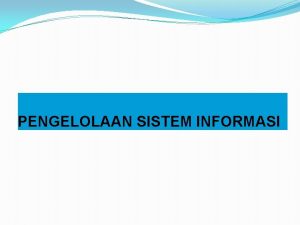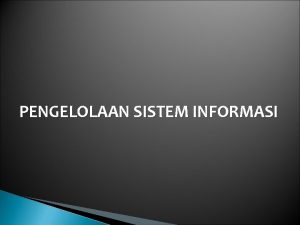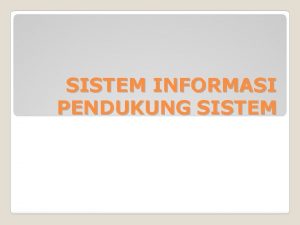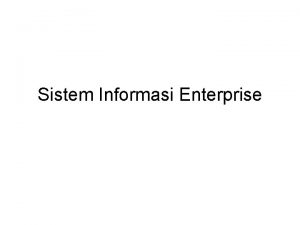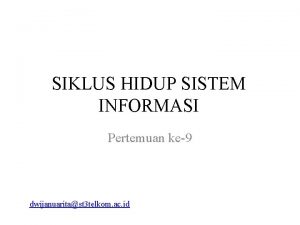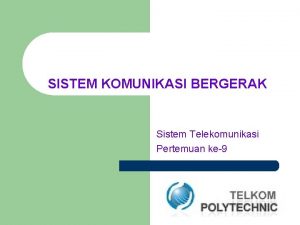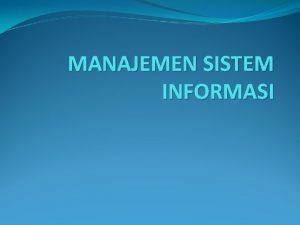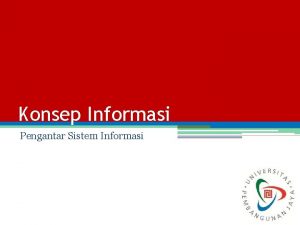ENTERPRISE RESOURCE PLANNING Pertemuan ke9 SISTEM INFORMASI ENTERPRISE













- Slides: 13

ENTERPRISE RESOURCE PLANNING Pertemuan ke-9 SISTEM INFORMASI ENTERPRISE Program Studi Teknik Informatika Universitas Komputer Indonesia

Introduction • ERP – integrates all departments and functions throughout an organization into a single IT system so that employees can make enterprisewide decisions by viewing enterprisewide information on all business operations. • ERP – Integration of financial, manufacturing and human resources on a single computer system. • Enterprise resource planning (ERP) is a term used to refer to a system that links individual applications (for example, accounting and manufacturing applications) into a single application that integrates the data and business processes of the entire business. RNL - 2014 2

Traditional Information System with Closed Database Architecture Business Enterprise Products Customer Orders Materials Order Entry System Customer Sales Account Rec Customer Database Manufacturing and Distribution System Procurement System Production Scheduling Shipping Vendor Accts Pay Inventory Manufacturing Database Purchas es Supplier Procurement Database 3

ERP System Business Enterprise Legacy Systems Data Warehouse ERP System On-Line Analytical Processing (OLAP) Bolt-On Applications (Industry Specific Functions) Suppliers Customers Core Functions [On-Line Transaction Processing (OLTP)] Sales & Distribution Business Planning Shop Floor Control Logistics Operational Database Customers, Production, Vendor, Inventory, etc. 4

5

Modules of ERP 1. Financial modules: These modules support the accounting and finance functions. 2. Manufacturing and logistics modules: These modules consist of a group of applications for planning production, taking orders and delivering products to the customer. 3. Human resource modules: These modules handle personnel related tasks for corporate managers and individual employees. RNL - 2014 6

Accounting and Finance Components Manage accounting data and financial processes within the enterprise with functions such as general ledger, accounts payable, accounts receivable, budgeting, and asset management. RNL - 2014 7

Production and Materials Management Components handle the various aspects of production planning and execution such as demand forecasting, production scheduling, job cost accounting, and quality control RNL - 2014 8

Human Resource Components Track employee information including payroll, benefits, compensation, performance assessment, and assumes compliance with the legal requirements of multiple jurisdictions and tax authorities RNL - 2014 9

Extended ERP Components • • Business intelligence - information that people use to support their decision-making efforts CRM - involves managing all aspects of a customer’s relationship with an organization to increase customer loyalty and retention and an organization’s profitability SCM - involves the management of information flows between and among stages in a supply chain to maximize total supply chain effectiveness and profitability E-business - means conducting business on the Internet, not only buying and selling, but also serving customers and collaborating with business partners RNL - 2014 10

E-Business Components • E-logistics – manages the transportation and storage of goods. • E-procurement – the business-to-business (B 2 B) purchase and sale of supplies and services over the Internet. RNL - 2014 11

ERP – CRM – SCM - MRP RNL - 2014 12

SAP’s ERP Modules Cash to Cash Covers all financial related activity: Accounts receivable GL Accounts payable Treasury Promote to Deliver Covers front-end customer-oriented activities: Marketing Quote and order processing Transportation Documentation and labeling After sales service Warranty & guarantees Design to Manufacture Covers internal production activities: Design Shop floor engineering reporting Production Contract/project engineering management Plant Subcontractor maintenance management Recruit to Hire Covers all HR & Payroll oriented activity: Time and attendance Payroll Travel and expenses Cash management Asset management Procure to Pay Covers sourcing activities: Vendor sourcing Purchase requisitioning Purchase ordering Purchase contracts Inbound logistics Supplier invoicing/ matching Supplier payment/ settlement Supplier performance Dock to Dispatch Covers internal inventory management: Warehousing Forecasting Distribution planning Replenishment planning RNL - 2014 Physical inventory Material handling
 Sap lieferplan kopierer sd
Sap lieferplan kopierer sd Sistem informasi sumber daya informasi
Sistem informasi sumber daya informasi Gambaran teknologi informasi
Gambaran teknologi informasi Enterprise resource planning example
Enterprise resource planning example Enterprise resource planning overview
Enterprise resource planning overview Application of enterprise resource planning
Application of enterprise resource planning Enterprise resource planning concepts
Enterprise resource planning concepts Cayenta mobile workforce management
Cayenta mobile workforce management Sistema erp adalah
Sistema erp adalah Pengertian erp system
Pengertian erp system Enterprise resource planning mary sumner
Enterprise resource planning mary sumner Concepts in enterprise resource planning
Concepts in enterprise resource planning Core and extended erp components
Core and extended erp components Enterprise resource planning ppt
Enterprise resource planning ppt
